More languages
More actions
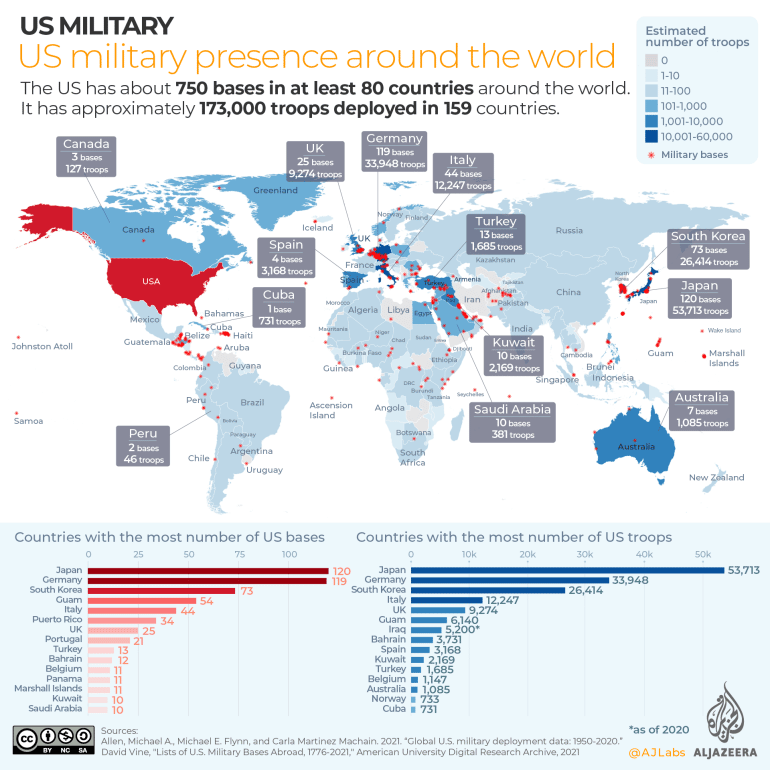
Anti-base movement is a term[1] which refers to various movements which focus on opposing aspects of military bases, which can range from opposition to specific activities of bases or base personnel, to opposing their presence or construction in particular locations, to opposing their existence in general. It can also refer to these movements collectively.[2]
Given that the majority of foreign military bases around the world are United States bases,[3][4][5] many anti-base movements around the world have been directed at U.S. bases.
Among the many grievances expressed by anti-base movement activists are issues such as criminal and negligent activity of base personnel, the environmental pollution and destruction generated by U.S. bases, the erosion of national sovereignty that occurs with the U.S. military presence in host locations, and the international provocations and tensions that occur when countries host US bases and collaborate with US military exercises (such as the biennial US-led RIMPAC exercises).[6]
Background
Prevalence of US bases
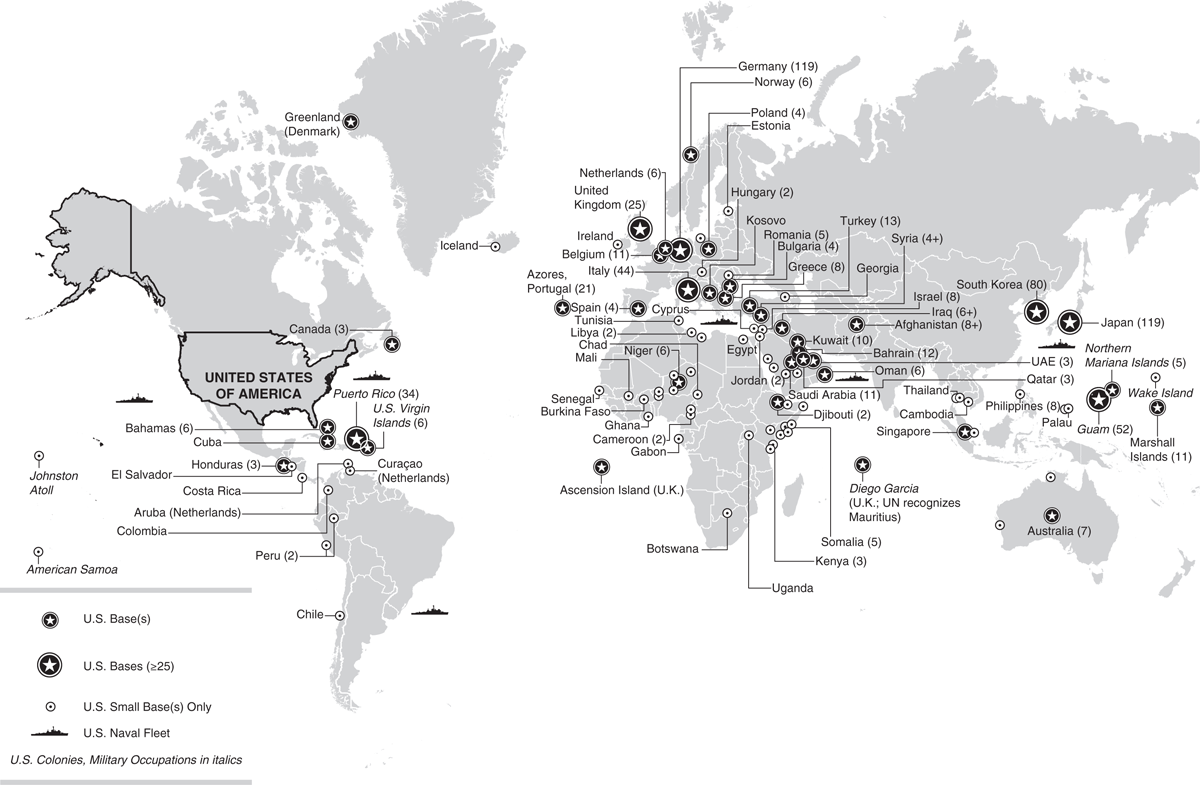
As of a 2021 estimate, the U.S. has approximately 750 bases around the world in at least 80 countries, with the largest concentration of them being in Japan (especially in Okinawa), followed by Germany and south Korea,[7] resulting in many corresponding anti-base movements. There are also anti-base movements within locations claimed by the U.S. as its own territory, some examples being Guam and Hawaiʻi.[8][9]
Additionally, some anti-base movements oppose bases which are not formally considered to be a US base by law, but which effectively serve as a US base. An example of this would be the Military-Civilian Port Complex in south Korea, technically a south Korean base, but which local activists have explained is a place where "strategic assets in the US military can stop by whenever they please according to American interests."[10]
Another example of a legally ambiguous de facto base is the West Africa Logistics Network (WALN) at Kotoka International Airport in Ghana, a "cooperative security location" where the US military and related personnel are afforded numerous privileges, including the ability to conduct construction activities and store defense equipment, supplies, and materiel, enter into Ghana without visa or passport nor customs inspection for U.S. personnel, and protection for U.S. soldiers from being prosecuted by Ghanaian authorities for crimes, following a 2018 Status of Forces Agreement.[11][12]
History of US bases
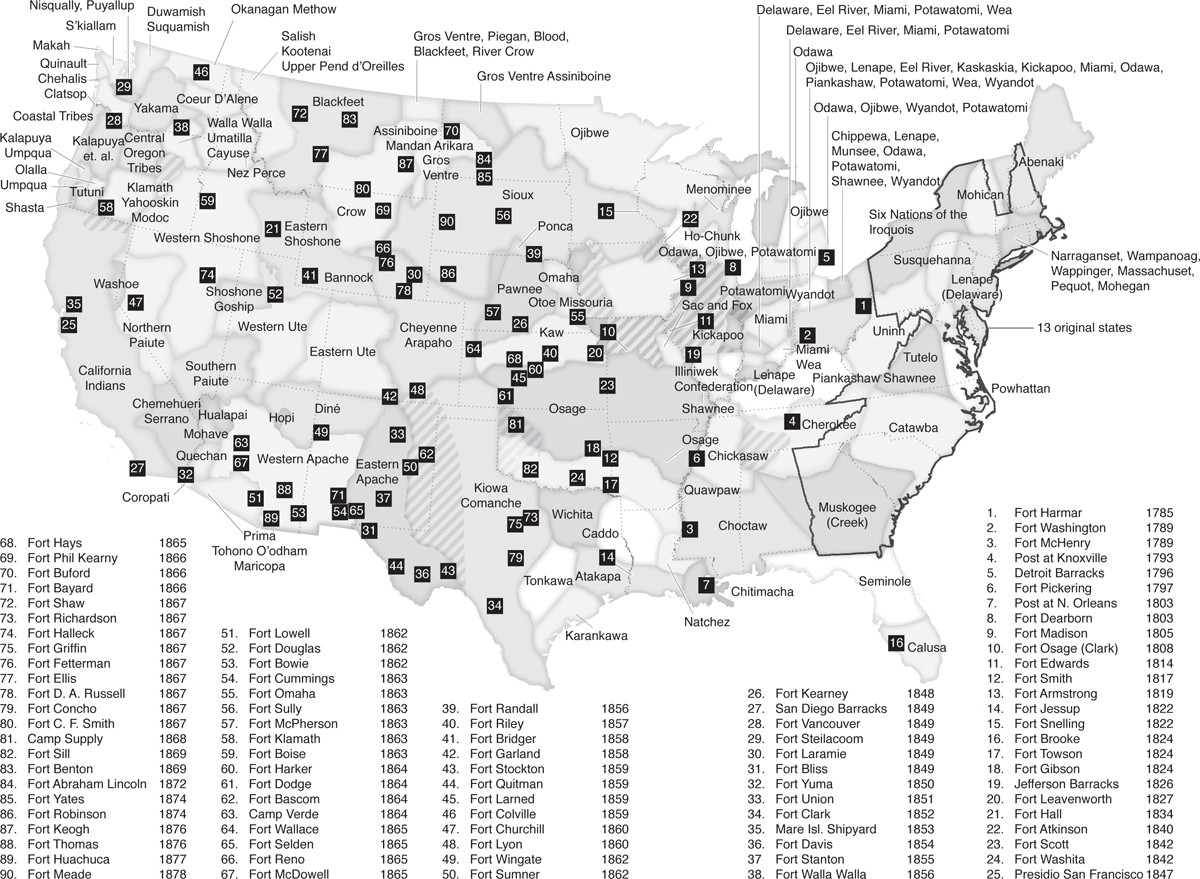
The US settler-colonial state was established on North America through a series of military forts expanding across the continent. The settler state used its military force to defend and advance "civilian" settlers (and their volunteer militias) in their encroachment on more and more land, including punishing indigenous peoples' defense of their borders agreed on in treaties with the settler state, and used its military presence to "force compliance" when indigenous tribes and bands refused to live on reservations or make treaties on the invading settlers' terms.[13] By this process of expanding military power across the continent, the US occupied much of North America, and then began expanding its base presence to numerous other locations throughout the world starting in the 1890s, leading to further resistance movements. For example, the US military "faced opposition and an insurgency seeking independence almost immediately after seizing the Philippines in 1898".[1]
Author David Vine describes the dynamics of coercion and power imbalance which has accompanied the establishment of many of the U.S.'s post-WWII bases which have, "to one degree or another" been "consented to" by the host nations' governments:
Although the United States has been an empire occupying Native American lands with military bases since independence, its post–World War II collection of foreign bases has been distinguished by the fact that most national governments have, to one degree or another, consented to the country’s presence [...] Importantly, however, this consent has come in a context of often gaping power disparities, where US officials have used US dominance, forms of political-economic coercion, and fears of the Soviet Union (at times, intentionally inflated) to ensure national governments consented to a US base presence.[1]
Issues with US bases
Violence toward local population
The violent crimes of U.S. military personnel and U.S. civilian contractors working in base areas include numerous killings and sexual assault crimes committed against the citizens of the countries where they are stationed.[14]
In addition to violence perpetrated by individual personnel against locals, negligence during routine activities of bases have also caused violent damage to local populations, such as people being seriously injured and killed by errant bombs.[15]
Areas with a base presence also face issues of increased sex trafficking. For example, in south Korea, a legally-sanctioned prostitution industry was purposely encouraged and maintained by the government in special zones around US bases, with this system persisting for decades.[16]
Environmental destruction
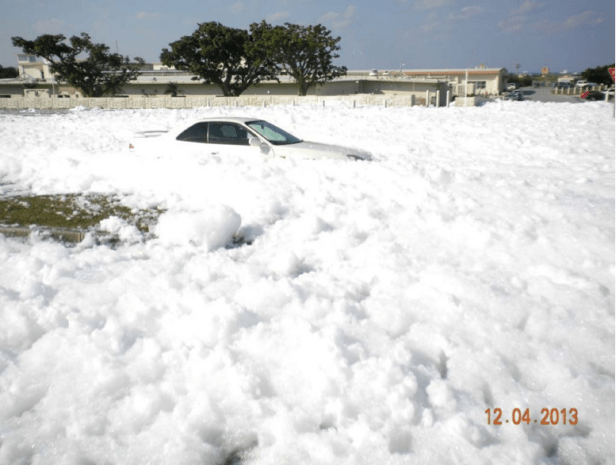
The environmental destruction brought about by base presence takes a range of forms, arising from the initial construction of the base and how it alters the environment, to the ongoing activities of the base in that particular location, to the after-effects that remain even after a base has ceased operation. Some examples of environmental hazards are leakages of jet fuel into local drinking water, toxic PFAS foam leaks, litter from practice drills bleeding chemicals into the ground and water, and extreme noise pollution. In addition to physically hazardous pollution, culturally or spiritually significant sites can be destroyed or desecrated by base presence. A 2018 petition by World Can't Wait to stop RIMPAC exercises, addressed to the then-governor of Hawaiʻi, describes further examples:
Retired military ships are towed out to sea and then targeted with missiles and torpedoes until they sink to a watery graveyard on the ocean floor. There they leach toxic chemicals, including PCBs, which accumulate in the bodies of fish, dolphins and whales – and ultimately into our food. Amphibious landing exercises, which include heavy tracked vehicles, damage reefs, erode shoreline, and endanger wildlife. [...] Areas that have been used for live fire training and bombing practice are uninhabitable; bombing and live fire practice is not only continuing but escalating in the age of the “Pacific Pivot”. Indigenous Hawaiian cultural sites have been destroyed. U.S. Military fuel storage tanks are leaking poisons into the drinking water in Hawai`i's most populous city. Vast areas of land and water are so toxic as to be unusable.[17]
National sovereignty concerns
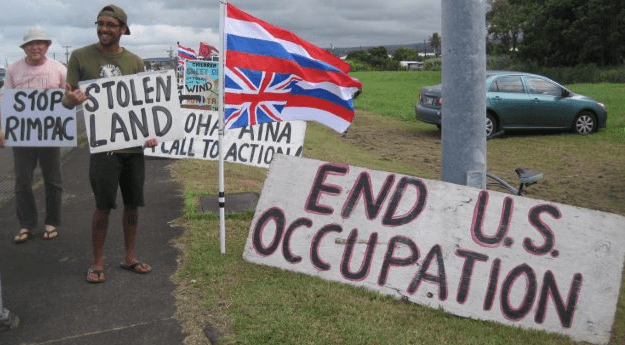
Bases may be established and their continuing presence maintained by a variety of methods, ranging from mutual legal agreements to brute force and occupation. Often, a combination of these factors is employed in installing and maintaining a base's presence when its presence is based in imperialist, bourgeois interests not premised on local popular support or when local popular support diminishes and wavers over time.
The presence of foreign bases in one's territory raises concerns over the effect the base presence has on national sovereignty in the host (or occupied) nation. This may range from issues such as which nation has authority to prosecute crimes committed by base personnel in the host country, to what the land area, local resources, and local labor consumed by the base could be otherwise used for by the host nation's populace, to the potential consequences that large concentrations of foreign military personnel and their equipment being present in the location may have on the host nation's overall national security, domestic policymaking, and diplomatic bargaining power.[18]
Status of Forces Agreements
The legal agreements made between countries to host foreign military personnel and how domestic laws apply to them are commonly known as Status of Forces Agreements (SOFAs). There is no standard form of SOFA and they may include a variety of provisions. In the case of SOFAs made with the U.S., the most commonly addressed issue in a SOFA is legal protection from prosecution for U.S. personnel while present in a foreign country, and whether the U.S. will exercise sole jurisdiction over U.S. personnel or shared jurisdiction with the host. SOFAs are not themselves security arrangements nor basing agreements. As is noted by a Congressional Research Service report, "a SOFA itself does not constitute a security arrangement; rather, it establishes the rights and privileges of U.S. personnel present in a country in support of the larger security arrangement." The 2012 report noted that, at time of writing, the U.S. was party to more than 100 agreements that may be considered SOFAs.[19]
Though SOFAs are not formally basing agreements, a 2021 article in The Tricontinental explains how Ghana's 2018 SOFA agreement nonetheless allows the U.S. such a level of authority over facilities in Ghana so as to be able to effectively set up a base through Articles 5 and 6 of the agreement, designating agreed facilities to be of "unimpeded" and "exclusive" use to the U.S. and that Ghana "shall also provide access to and use of a runway that meets the requirements of United States forces."[12] Furthermore, the agreement gives the U.S. forces and U.S. contractors the ability to "undertake construction activities" and make alterations to agreed facilities and to "preposition and store defense equipment, supplies, and materiel" at agreed facilities and areas,[20] gives U.S. soldiers the right to carry arms on duty, allows U.S. army and civilians to enter Ghana without a passport nor a visa but just identification cards, allows the U.S. army to not take responsibility for the death of any other person aside from U.S. military personnel, and third party issues involving U.S. military personnel will only be resolved according to the laws of the United States, among other preferential treatments.[20][21][11] Such agreements between the U.S. and Ghana have led to the establishment of the West Africa Logistics Network (WALN) at Kotoka International Airport in Accra to "ferry supplies and arms to special forces troops across the region".[22]
War provocations
The presence of military bases in a location leads to the concern of that location becoming a strategically significant location with regard to international tensions involving the host country, the hosted country, and their various neighbors, allies, targets, and/or rivals. People who live in the host nation are confronted with the potential wartime actions resulting from the presence of a base in their territory in addition to the peacetime concern of the base's potential to provoke international tensions, such as through military build-up, exercises, and shows of force. Individuals and organizations within anti-base movements may express a variety of perspectives on such issues, such as locals' urgent safety concerns over their location becoming a diplomatic pawn or wartime hotspot, general anti-war or pacifist sentiments, promotion of non-alignment, and explicitly anti-imperialist sentiment.[1]
In the present-day context, of high concern in host locations of US bases is what this portends in regard to conflicts between the US-led imperialist bloc on one hand, and the imperialists' perceived or declared targets and rivals on the other, sometimes referred to as the New Cold War.[23]
As political scientist and Guam independence advocate[24] Kenneth Gofigan Kuper has described, writing about the highly militarized US colony of Guam:
In the coming years, I am afraid things will get worse for the people of Guam unless restraint enters the picture. [...] One of Guam’s former non-voting representatives in Congress, Ben Blaz, once said of our island, “We are equal in war, but not in peace.” I think he was only half-right. While we are clearly not equal in peace, as no colony can be, we are NOT equal in war. We in Guam bear the brunt of U.S. power projection in the Indo-Pacific, both as provocative threat and as a target. The task of securing a “free and open” Indo-Pacific is disproportionately on our backs.[25]
Representing Oceania Rising at a 2017 talk about militarization and resistance in the Pacific, Kuper gave an example of the dynamic at play in US-occupied Guam, where the U.S. military presence threatens Guam more than protects it. Explaining that Guam is within range of China's IRBM the DF-26, as well as within the range of the DPRK's precision strike means, Kuper stated "I remember, when all this news was coming out, you had people on Facebook and social media saying, 'Thank God the U.S. military is here. They're gonna protect us from these threats.' And I countered, saying, 'Why the Hell are these threats here to begin with--in Guam? It's exactly the United States military presence.'" Kuper continued, clarifying that rather than offering protection, the military presence "makes everything so much more dangerous." He added that the people of Guam experience periodic threats over geopolitical tensions, stating "we are pawns in a game we don't even want to be a part of."[26]
Bases and anti-base movements by location
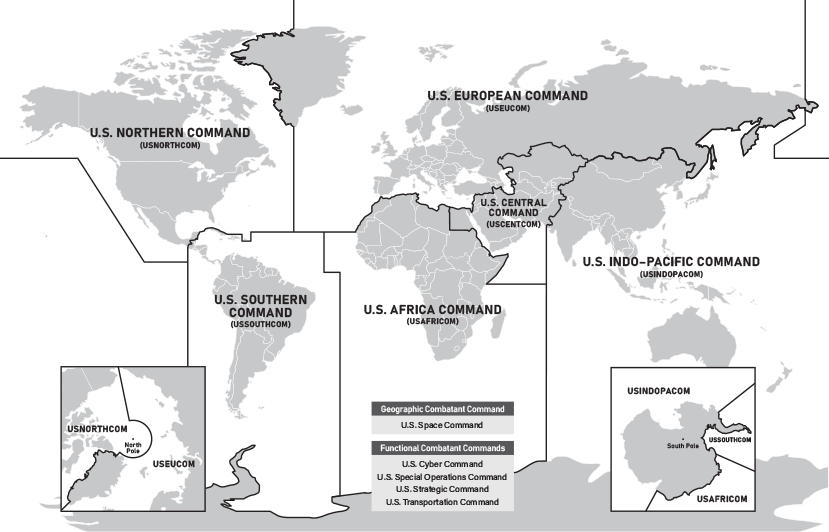
The United States Department of Defense (DOD) divides its commands into various areas of responsibility (AOR), with seven combatant commands covering geographic areas (one of them being US Space Command), while the remaining commands cover functions such as transportation and special operations.[27][28] As US bases are generally managed and strategically conceptualized according to this structure, and likewise anti-base movements in different nations are thus strategically linked and affected by which areas of responsibility they fall under or adjoin, this section will be divided roughly following its scheme and some of its terminology.
Africa
Middle East
Europe
Indo-Pacific
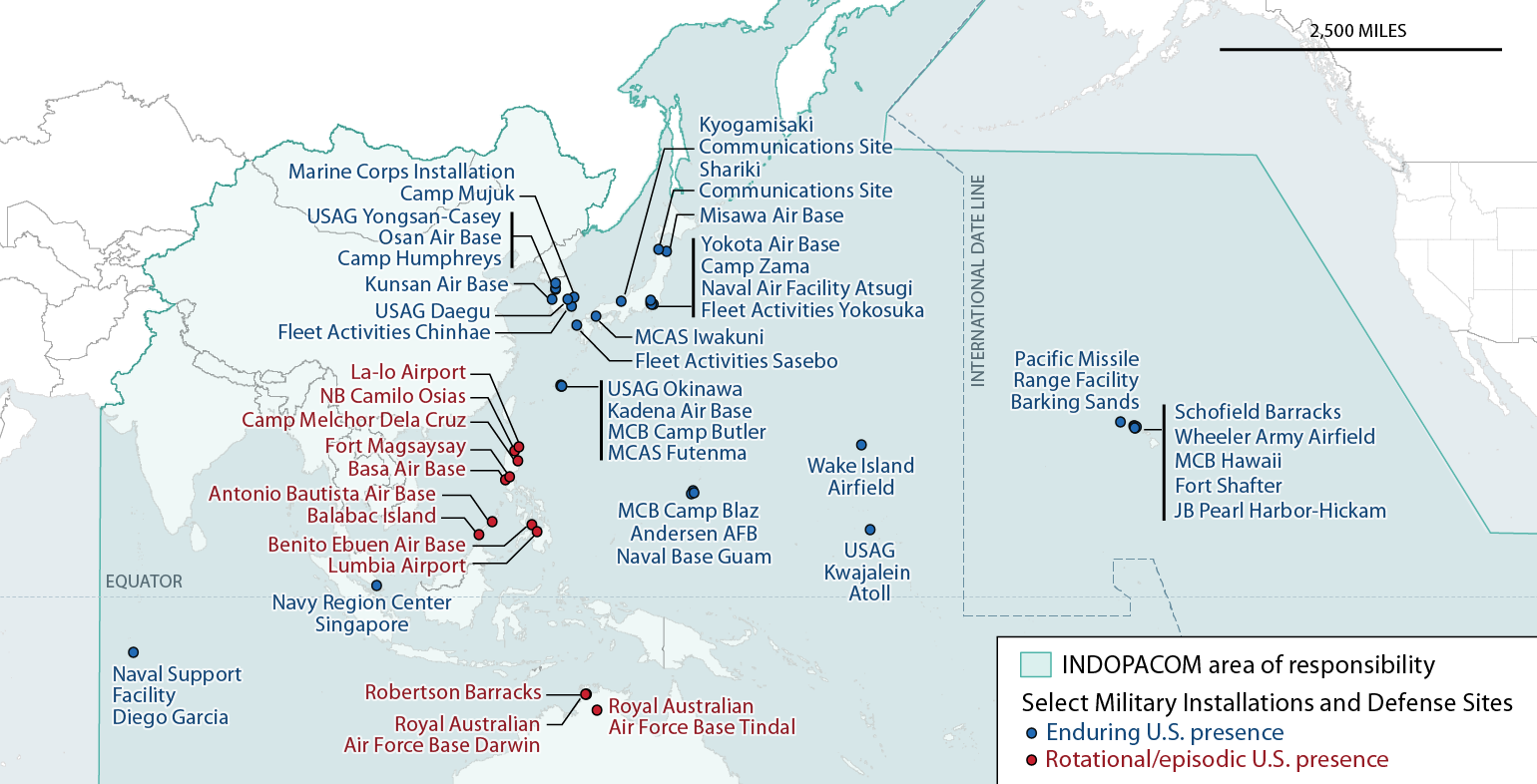
The U.S. designates the area covering the Pacific Ocean, Indian Ocean, and much of Asia as USINDOPACOM. It is the oldest and largest of the U.S.'s unified commands, and it has been referred to by the DOD as its "priority theater". The DOD has identified competition with China as the organizing principle of the Indo-Pacific posture since the early 2010s.[29] Its area of responsibility covers more area than any of the other geographic commands and shares borders with all five of the other geographic commands.[30]
U.S. military presence in the Indo-Pacific is headquartered in the occupied nation of Hawaiʻi,[31] whose sovereign government the US Navy overthrew in an 1893 coup.[32] Some of the US's most significant overseas bases and forces are in the Indo-Pacific, with many positioned in south Korea and Japan, as US strategy in this area targets China, DPRK, and Russia. This area is the location of the world's largest maritime exercise, the US-led RIMPAC.[33]
In Oceania, the U.S. has significant air and naval bases on its occupied colony Guam, and operates the Ronald Reagan Ballistic Missile Defense Test Site at Kwajalein Atoll in the Marshall Islands. The Department of Defense is building a high-frequency radar system in Palau. Additionally, the U.S. military has ties with Fiji, Papua New Guinea, and Tonga.[31] Also significant is the Diego Garcia base in the Indian Ocean, built after the forced displacement of the island's inhabitants through a joint US-UK effort.[34][35]
Japan
Okinawa has more than half of the 54,000 U.S. troops based in Japan.[29] Okinawa was once the independent Ryukyu Kingdom which was then colonized by Japan, later falling under the rule of the United States for 27 years (until 1972),[36] and is currently regarded as a Japanese prefecture.[37] Protests against US occupation and land seizures in Okinawa began within months of the end of the Second World War.[1]
Sunagawa struggle
In the 1950s, a significant anti-base struggle emerged in the Tokyo suburb Sunagawa, in protest of the expansion of Tachikawa Air Base. The expansion was to occur via land expropriations on behalf of the U.S. Air Force,[1] slated to evict 140 families from their homes and farmland.[38] The local farmers began trying to prevent the work of land surveyors, such as by blocking the path of their vehicles and forming the Sunagawa Anti-Base Expansion Alliance. Over time, regional and national labor unions, student groups, Buddhist monks and nuns, lawmakers and other citizens became involved in the struggle as well.[38] A report in The Japan Times explains that by 1956, "2,000 police officers were ordered to evict the farmers from the land that they continued to occupy, only to be met with 6,000 protesters, resulting in a clash that left roughly 1,000 people injured, many seriously." The struggle against the base expansion continued, and by 1968, the U.S. military "quietly announced it had given up on the planned runway extension" and returned the base to the Japanese government in 1977.[38]
Dennis Banks, who would later be a co-founder of the American Indian Movement, was present during some of these events in 1956, while stationed in Japan at age 17. Banks described being ordered to "shoot to kill" if the demonstrators entered the base and did not respond to warning shots, and recounted feeling unable to comprehend the order: "We could not understand this. These people were nothing more than nonviolent demonstrators. This was their land that our Air Force was trying to take away." Banks then witnessed the Japanese police rushing the demonstrators "in a frenzy" and "cracking skulls with a terrible sound" and Banks saw "elderly nuns with blood streaming down their faces." Banks recounted, "I felt sick at what I had seen and ashamed of the uniform I was wearing. [...] That terrible scene has remained with me all of these years. I shall never forget those demonstrators were peaceful people literally being beaten to death. Since that time, during my struggles in the American Indian Movement, I have seen BIA police wield their clubs at Indians like that. Each time my memory flashed back to what I saw that day in Japan." Soon, following these and other experiences while "guarding the ramparts of the American Empire" in Japan, Banks went AWOL and "wanted nothing more to do with the military or the U.S. government."[39]
Korea
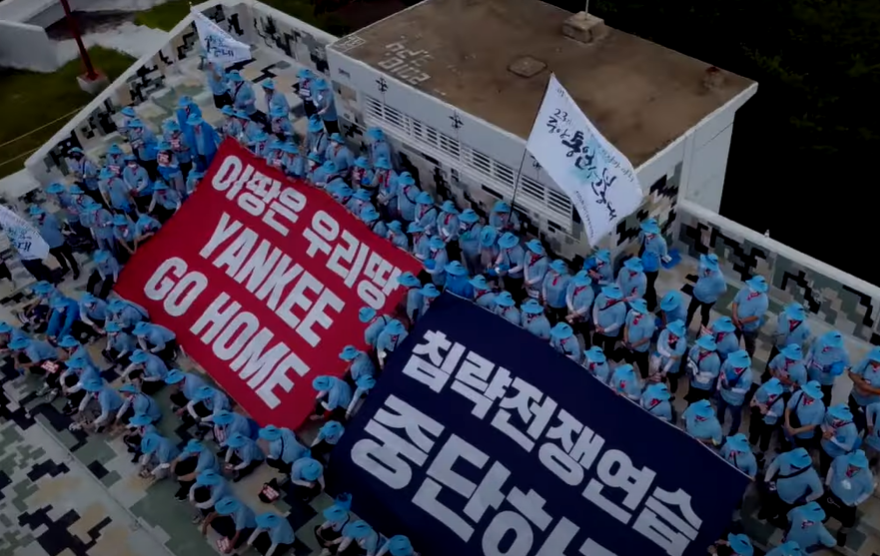
The single nation of Korea has been divided by U.S. occupation since shortly after the Second World War, when the U.S. refused to withdraw its forces and helped orchestrate the holding of separate elections in the south, establishing the "Republic of Korea," a U.S. puppet state ruled by a series of right-wing dictatorships, which the U.S. continues to occupy and reserves control over the south Korean military during wartime. This puppet state is postured against the DPRK, which formed after the U.S.-sponsored separate elections in the south.[42]
Anti-US and anti-base movements in south Korea have existed since the beginning of U.S. occupation in Korea and continue to this day, both on the mainland of the Korean peninsula and on Jeju Island, where locals and their supporters (including activists from other occupied nations in the Pacific)[43] attempted to prevent the construction of a naval base for over a decade.[44]
Maehyang-ri Kooni Firing Range
Between 1954 and 2005, two small islets, accessible by foot at low tide, off the coast of the village of Maehyang-ri were used as a bombing range for the U.S. Air Force. Residents of Maehyang-ri suffered deaths and injuries from errant bombs, extreme noise exposure, psychological damage, a heightened suicide rate, and pollution of the land and sea. Media coverage of the firing range was forbidden until south Korea's democratization movement in 1988.[15]
An article from 2000, before the range's closure, describes the situation at the time, stating that overall management of the range had been contracted out to Lockheed Martin. The firing range's activities are described as follows:
The Kooni Range is composed of a bombing range for bomber planes on the Nong-do island (which can be reached on foot during low tide) off the coast and a strafing range on the edge of the village. U.S. Air Force fighter jets and bombers, such as F-16, A-10, and OV-10, not only from the U.S. Air Force based in Korea, but also in Okinawa, Thailand, Guam, and the Philippines swoop on Maehyang-ri to drop their bombs and spray their bullets on the targets in the range in bombing practice and gunnery drills. The bombing and firing take place throughout the daylight hours and even until late at night for 250 days a year, stopping only for weekends and holidays.[45]
Though persistent struggle against the firing range finally resulted in its 2005 closure, the U.S. Air Force made no known effort to clean up the bombs left over from practice drills, leaving used shells to disintegrate and bleed chemicals into the ground and water. Fishermen from the village have trouble selling their products as some buyers are concerned over the contamination. Meanwhile, residents who were not killed by errant bombs from the range live with physical and psychological damages and the remaining pollution of their village.[15]
Soseong-ri anti-THAAD struggle
Since the US's introduction of the Terminal High Altitude Area Defense (THAAD) system, residents of the village of Soseong-ri have conducted ongoing protests against it, regularly holding rallies on the road leading to the THAAD site and coming into conflict with the police who were tasked with clearing the protestors to make way for US military supply trucks.[46]
Hawaiʻi
Kahoʻolawe struggle
The island of Kahoʻolawe was taken under U.S. military control during the Second World War, first by a 1941 sublease from Kahoʻolawe Ranch Company, where the U.S. Army acquired bombing rights for $1 per year. It was then sequestrated by the Army for use as a live ordinance training area and its southern and eastern cliffs used for torpedo bomb testing and its western beaches as practice landing areas as rehearsal for Tarawa, Okinawa, and Iwo Jima. Following the war, the island was placed under the jurisdiction of the secretary of the U.S. Navy and continued to be used as a bombing target.[47]
Pōhakuloa Training Area
Mākua Valley Struggle
Shut Down Red Hill
A fuel storage facility built during the Second World War and located on Kapūkaki, also known as Red Hill, has been leaking since 1943, releasing a conservative estimate of 200,000 gallons of fuel into the surrounding environment. It is located just 100 feet (30.48 meters) above Oʻahu’s primary drinking water supply. A 2021 fuel leak from the facility poisoned the water system for nearly 100,000 residents, sending thousands of people into acute reactions due to petroleum exposure.[48] Following the incident, more than 70 organizations joined in the cause for closing Red Hill, including organizations such as Oʻahu Water Protectors and the Sierra Club. The military initially denied the problems, but finally suspended operation of the facility, though still fought against citizens' demands to close the facility completely. In the face of continued pressure, the Department of Defense eventually agreed to shut down the facility.[9]
Though the DoD agreed to shut down the facility, the medical repercussions for citizens harmed by the past leaks are ongoing, and residual fuel remains in the facility and the soil which poses a danger of contaminating Oʻahu's sole source aquifer. Speaking on the state of affairs in a 2024 interview with The Red Nation, activist Mikey Inouye commented "At this point, we are going to have to organize around Red Hill for, probably, the rest of our lives."[49] Inouye observed that the facility was not "defueled" so much as it was "dispersed [...] into our drinking water, into our sole source aquifer that provides water to nearly half a million people on the this island, it was dispersed into our bloodstreams, into the blood of children, including civilian children, including Kānaka Maoli children--Native Hawaiians, into our ecosystem, into our other-than-human relatives, and until that is removed from Hawaiʻi, Red Hill, to me, has not been shut down yet. And so, it's going to be the work of, possibly, generations."[49]
Guam
Guåhan, also called Guam, is a heavily militarized US colony with 27% of its land occupied by the US military. Guam is sometimes referred to as the "tip of the spear" of US military presence in the Pacific.[50]
Philippines
Diego Garcia
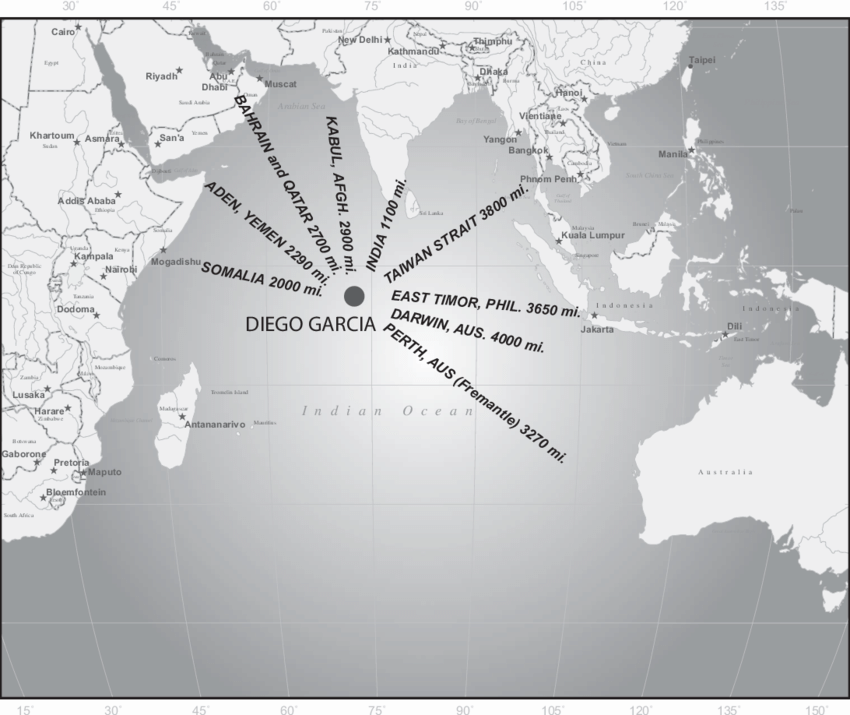
Diego Garcia is part of the Chagos Islands in the Indian Ocean, where a U.S. base is sustained on a British land lease. Over a ten year period beginning in 1965, a joint US-UK effort expelled the population in order to build a US military base.[34][35] John Pilger, writing in Al Jazeera, explained: "People were herded into the hold of a rusting ship, the women and children forced to sleep on a cargo of bird fertiliser. They were dumped in the Seychelles, where they were held in prison cells, and then shipped onto Mauritius, where they were taken to a derelict housing estate with no water or electricity. Twenty-six families died there in brutal poverty, nine individuals committed suicide, and girls were forced into prostitution to survive."[51]
The strategically significant location of Diego Garcia enables the U.S. military to reach numerous locations, for example helping to launch the U.S. bombings of Iraq and Afghanistan.[51][52]
Though not strictly an anti-base movement, there is a movement for the survivors of the forced expulsion to be able to return to their home. However, this has been blocked by various political maneuvers by the West, including by the establishment of a marine nature reserve in the area, which would prevent them from engaging in necessary subsistence fishing if they were able to return.[51][35]
North America
South America
See also
External links
- USA’s Military Empire: A Visual Database by World Beyond War. A database of the USA's network of military bases around the world, with an interactive map.
References
- ↑ 1.0 1.1 1.2 1.3 1.4 1.5 “I use the term “antibase movement” because it is widely used by movement members and scholars and because such movements, strictly speaking, are “anti-” in the sense that they are opposed to some aspect of the life of a base or its personnel.”
David Vine (2019). No Bases? Assessing the Impact of Social Movements Challenging US Foreign Military Bases, vol. Volume 60, Number S19. [PDF] Current Anthropology. - ↑ Yeo, Andrew. "Not in Anyone's Backyard: The Emergence and Identity of a Transnational Anti-Base Network." International Studies Quarterly, Vol. 53, No. 3 (Sep., 2009), pp. 571-594. Oxford University Press.
- ↑ David Vine, Patterson Deppen and Leah Bolger. "Drawdown: Improving U.S. and Global Security Through Military Base Closures Abroad." Quincy Institute for Responsible Statecraft, September 20, 2021. Archived 2024-03-12.
- ↑ Jawad, Ashar. "5 Countries With the Most Overseas Military Bases." Insider Monkey, December 15, 2023.
- ↑ "Why 90% Of Foreign Military Bases Are American." AJ+ on YouTube, Jan 13, 2022.
- ↑ “The Feminist Response to RIMPAC and the US War against China.” Friends of Socialist China, July 27, 2022. Archived 2023-09-22.
- ↑ Mohammed Hussein and Mohammed Haddad. "Infographic: US military presence around the world." Al Jazeera, 10 September 2021. Archived 2024-03-28.
- ↑ Chris Gelardi and Sophia Perez. “‘Biba Guåhan!’: How Guam’s Indigenous Activists Are Confronting Military Colonialism.” The Nation, October 21, 2019.
- ↑ 9.0 9.1 Jedra, Christina. “How Hawaii Activists Helped Force the Military’s Hand on Red Hill.” Honolulu Civil Beat, March 14, 2022. Archived 2022-02-22.
- ↑ “American Nuclear Submarine Enters Jeju Naval Base.” Hankyoreh, 2017. Archived 2023-03-25.
- ↑ 11.0 11.1 Prashad, Vijay. “Why Does the United States Have a Military Base in Ghana?” Peoples Dispatch, June 15, 2022. Archived 2024-03-18.
- ↑ 12.0 12.1 “Defending Our Sovereignty: US Military Bases in Africa and the Future of African Unity.” Tricontinental: Institute for Social Research, July 5, 2021. Archived 2023-03-04.
- ↑ Stewart, Richard W. "American Military History." Chapter: "Winning the West: The Army in the Indian Wars, 1865-1890." Volume 1: The United States Army and the Forging of a Nation, 1775-1917. Second Edition. Center of Military History, United States Army. Washington, D.C., 2009. Archived 2024-04-22.
- ↑ Mitchell, Jon. “NCIS Case Files Reveal Undisclosed U.S. Military Sex Crimes in Okinawa.” The Intercept. October 3, 2021. Archived 2022-08-06.
- ↑ 15.0 15.1 15.2 "Bombing ends, but village still not free from past." Yonhap News Agency. September 12, 2012. Archived 2022-09-27.
- ↑ Shorrock, Tim. “Welcome to the Monkey House.” The New Republic. December 2, 2019. Archived 2022-09-26.
- ↑ "For People, Land, Air and Sea: Stop RIMPAC Military Exercises." Petition to Governor of Hawaii David Ige, started by World Can't Wait-Hawai`i. Change.org, May 17, 2018. Archived 2024-04-03.
- ↑ Yeo, Andrew. "Security, Sovereignty, and Justice in U.S. Overseas Military Presence." International Journal of Peace Studies, Volume 19, Number 2, Winter 2014. Archived 2023-04-13.
- ↑ "Status of Forces Agreement (SOFA): What Is It, and How Has It Been Utilized?" Congressional Research Service, March 15, 2012. (PDF). Archived 2024-04-15.
- ↑ 20.0 20.1 "Agreement Between the UNITED STATES OF AMERICA and GHANA." May 9, 2018. United States Department of State.
- ↑ Maxwell Boamah Amofa. “The Sandhurst Colonial Mentality and the Rule of Law.” Modern Ghana. March 13, 2023. Archived 2023-02-14.
- ↑ Katie Bo Williams. “AFRICOM Adds Logistics Hub in West Africa, Hinting at an Enduring US Presence.” Defense One, February 20, 2019. Archived 2024-04-02.
- ↑ Joseph Gerson and Michael Klare. "Statement on Averting a New Cold War Between the United States and China." Committee for a SANE U.S.-China Policy, October 2020. Archived 2022-01-19.
- ↑ Michael Lujan Bevacqua. “In Wake of Trump’s Win, Let’s Consider Independence for Guåhan.” The Guam Daily Post, November 19, 2016.
- ↑ Kenneth Gofigan Kuper. "Living at the tip of the spear: Guam and restraint." Responsible Statecraft, July 21, 2020. Archived 2023-09-27.
- ↑ "Militarization and Resistance in the Pacific, In the Age of Trump." University of Hawai'i at Manoa, March 13, 2017. APECEpic on YouTube, Apr 1, 2017. Archived 2024-04-18.
- ↑ “USAFA Library Guides: Combatant Commands: Combatant Command Overview.” U.S. Air Force Academy.
- ↑ "Combatant Commands." U.S. Department of Defense. Archived 2023-04-15.
- ↑ 29.0 29.1 29.2 "U.S. Indo-Pacific Command (INDOPACOM)." Congressional Research Service, March 5, 2024.
- ↑ "USPACOM Area of Responsibility." U.S. Indo-Pacific Command.
- ↑ 31.0 31.1 "The Pacific Islands." Congressional Research Service, January 25, 2024. Archived 2024-02-11.
- ↑ Jon Olsen (2022-11-15). "Hawai’i—The Very First U.S. Regime Change." CovertAction Magazine. Archived from the original on 2022-11-16.
- ↑ Takahashi Kosuke. “US-Led RIMPAC, World’s Largest Maritime Exercise, Starts without China or Taiwan.” The Diplomat, July 01 2022. Archived 2024-02-26.
- ↑ 34.0 34.1 Asoka Bandarage. “U.S. Military Presence and Popular Resistance in Sri Lanka.” CovertAction Magazine, August 12, 2019. Archived 2023-10-03.
- ↑ 35.0 35.1 35.2 David Vine. “The Truth about the U.S. Military Base at Diego Garcia.” Truthdig, June 15, 2015. Archived 2023-01-29.
- ↑ Sayo Saruta. “Okinawa’s Peace Movement Carves Its Own Path.” The Japan Times, March 4, 2024. Archived 2024-04-06.
- ↑ Moé Yonamine. “Fighting for Okinawa.” MR Online, July 28, 2017. Archived 2023-09-28.
- ↑ 38.0 38.1 38.2 Dustin Wright. "‘Sunagawa Struggle’ ignited anti-U.S. base resistance across Japan." The Japan Times, May 3, 2015. Archived 2015-05-05.
- ↑ Dennis Banks, Richard Erdoes. "Ojibwa Warrior: Dennis Banks and the Rise of the American Indian Movement." University of Oklahoma Press, 2004.
- ↑ 김준. (Kim Jun). "쌍용훈련 재개 예고에 23기 중앙통선대, 포항 한미연합상륙훈련장 지휘소 기습점거투쟁" ("23rd Central Telecommunication Battalion, Pohang ROK-U.S. Combined Amphibious Training Center Command Post, Surprise Occupation Struggle to Announce Resumption of Ssangyong Training"). 노동과세계. 2022.08.12. Archived 2022-08-28.
- ↑ "23기 민주노총 중앙통일선봉대 활동영상" ("23rd KCTU Central Unification Vanguard Activity Video"). 민주노총 (Confederation of Trade Unions). Aug 14, 2022. YouTube.
- ↑ People's Democracy Party and Liberation School. “70 Years Too Long: The Struggle to End the Korean War.” 25 June 2020. Archived 2023-09-26.
- ↑ “With RIMPAC, South Korea Expands Its Military Footprint.” Friends of Socialist China, August 2022. Archived 2023-09-27.
- ↑ Benjamin, Medea. “Korea’s Jeju Island: A Model for Opposing Militarism.” Telesurenglish.net. teleSUR. 2015. Archived 2020-01-19.
- ↑ "Maehyang-ri: From a Firing Range to a Test Ground for Human Rights and International Justice." National Action Committee for the Closure of the Maehyang-ri U.S. Armed Forces International Bombing Range (August 15, 2000).
- ↑ Elich, Gregory. "The Fight Over THAAD in Korea." Counter Punch, May 1, 2024. Archived 2024-05-03.
- ↑ "History." Protect Kaho'olawe 'Ohana.
- ↑ "Shut Down Red Hill." Sierra Club of Hawaiʻi.
- ↑ 49.0 49.1 Mikey Inouye, Jen Marley. "From Hawai’i to Palestine, occupation is a crime w/ Mikey." Episode 348, The Red Nation Podcast, March 5, 2024. Archived 2024-05-03. (YouTube version).
- ↑ Kenneth Gofigan Kuper. “Guam: The Sharpening of the Spear’s Tip.” Foreign Policy In Focus, July 20, 2022. Archived 2024-01-28.
- ↑ 51.0 51.1 51.2 Pilger, John. “How Britain Forcefully Depopulated a Whole Archipelago.” Al Jazeera, February 25, 2019. Archived 2023-03-31.
- ↑ Marsh, Jenni. “Is the United States about to Lose Control of Its Secretive Diego Garcia Military Base?” CNN, March 9, 2019.
